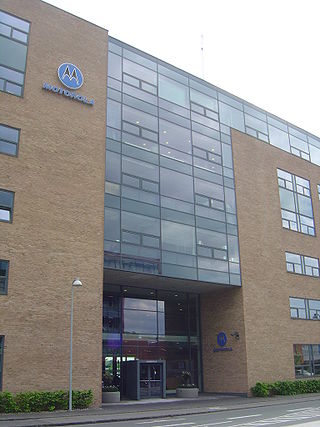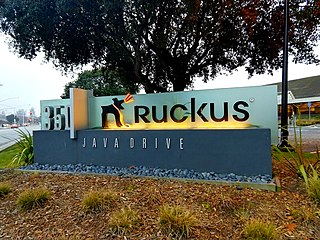Related Research Articles

Motorola, Inc. was an American multinational telecommunications company based in Schaumburg, Illinois. It was founded in 1928 as Galvin Manufacturing Corporation by brothers Paul and Joseph Galvin. The company changed its name to Motorola in 1947. After having lost $4.3 billion from 2007 to 2009, Motorola was split into two independent public companies, Motorola Mobility and Motorola Solutions, on January 4, 2011. The reorganization was structured with Motorola Solutions legally succeeding Motorola, Inc., and Motorola Mobility being spun off.

In telecommunications, a repeater is an electronic device that receives a signal and retransmits it. Repeaters are used to extend transmissions so that the signal can cover longer distances or be received on the other side of an obstruction. Some types of repeaters broadcast an identical signal, but alter its method of transmission, for example, on another frequency or baud rate.
nCUBE was a series of parallel computing computers from the company of the same name. Early generations of the hardware used a custom microprocessor. With its final generations of servers, nCUBE no longer designed custom microprocessors for machines, but used server-class chips manufactured by a third party in massively parallel hardware deployments, primarily for the purposes of on-demand video.

Silicon Forest is a nickname for the Washington County cluster of high-tech companies located in the Portland metropolitan area in the U.S. state of Oregon, and most frequently refers to the industrial corridor between Beaverton and Hillsboro in northwest Oregon.
Hybrid fiber-coaxial (HFC) is a broadband telecommunications network that combines optical fiber and coaxial cable. It has been commonly employed globally by cable television operators since the early 1990s.

A cable modem termination system is a piece of equipment, typically located in a cable company's headend or hubsite, which is used to provide high speed data services, such as cable Internet or Voice over Internet Protocol, to cable subscribers. A CMTS provides many of the same functions provided by the DSLAM in a DSL system.
Pace plc was a British company which developed set-top boxes (STBs), advanced residential gateways, software and services for the pay-TV and broadband services industry. Pace's customers included cable, telco, satellite and IPTV operators. The company was listed on the London Stock Exchange until December 2015, when the company received the last of the regulatory clearances needed to allow a merger with Arris Group to proceed. In 2019, Arris was subsequently acquired by network infrastructure provider CommScope.

Scientific Atlanta, Inc. was a Georgia, United States–based manufacturer of cable television, telecommunications, and broadband equipment. Scientific Atlanta was founded in 1951 by a group of engineers from the Georgia Institute of Technology, and was purchased by Cisco Systems in 2005 for $6.9 billion after Cisco received antitrust clearance for the purchase. The Cisco acquisition of Scientific Atlanta was ranked in the top 10 of largest technology acquisitions in history and was Cisco's largest acquisition to date. Prior to the purchase, Scientific Atlanta had been a Fortune 500 company and was one of the top 25 largest corporations in Georgia.
Jerrold Electronics was an American provider of cable television equipment, including subscriber converter boxes, distribution network equipment, and headend equipment in the United States.

In the field of telecommunications, the concept of triple play service refers to the provision of three essential services — high-speed broadband Internet access, television, and latency-sensitive telephone services — all delivered over a single broadband connection. This approach emphasizes the convergence of multiple services by a single supplier, aiming to enhance user convenience and streamline service delivery.
The Technology and Engineering Emmy Awards, or Technology and Engineering Emmys, are one of two sets of Emmy Awards that are presented for outstanding achievement in engineering development in the television industry. The Technology and Engineering Emmy Awards are presented by the National Academy of Television Arts and Sciences (NATAS), while the separate Primetime Engineering Emmy Awards are given by its sister organization the Academy of Television Arts & Sciences (ATAS).

Axis Communications AB is a Swedish manufacturer of network cameras, access control, and network audio devices for the physical security and video surveillance industries. Since 2015, it operates as an independent subsidiary of Canon Inc.
NCUBE may refer to:
Arris International Limited is an American telecommunications equipment company engaged in data, video and telephony systems for homes and businesses. On April 4, 2019, Arris was acquired by network infrastructure provider CommScope.

Switched video or switched digital video (SDV), sometimes referred to as switched broadcast (SWB), is a telecommunications industry term for a network scheme for distributing digital video via a cable. Switched video sends the digital video more efficiently freeing bandwidth. The scheme applies to digital video distribution both on typical cable TV systems using QAM channels, or on IPTV systems.

CommScope Holding Company, Inc. is an American network infrastructure provider based in Hickory, North Carolina. CommScope employs over 30,000 employees. The company joined the Nasdaq stock exchange on October 25, 2013.

RUCKUS Networks is a brand of wired and wireless networking equipment and software owned by CommScope. Ruckus offers Switches, Wi-Fi access points, CBRS access points, Controllers, Management systems, Cloud management, AAA/BYOD software, AI and ML analytics software, location software and IoT controller software products to mobile carriers, broadband service providers, and corporate enterprises. As a company, Ruckus invented and has patented wireless voice, video, and data technology, such as adaptive antenna arrays that extend signal range, increase data rates, and avoid interference, providing distribution of delay-sensitive content over standard 802.11 Wi-Fi.
A smart TV, also known as a connected TV (CTV), is a traditional television set with integrated Internet and interactive Web 2.0 features that allow users to stream music and videos, browse the internet, and view photos. Smart TVs are a technological convergence of computers, televisions, and digital media players. Besides the traditional functions of television sets provided through traditional broadcasting media, these devices can provide access to over-the-top media services such as streaming television and internet radio, along with home networking access.
Starlight Networks was founded in 1991 by Charlie Bass, Jim Long and Mark Gang with backing from investors Accel Partners and Interwest Partners. The company created some of the first commercial video-on-demand and video streaming products. The first Starlight Networks product was named StarWorks and enabled on-demand MPEG1 full motion videos to be randomly accessed on corporate IP networks. Later a version was released for Novell named Starware.
Harmonic Inc. is an American technology company that develops and markets video routing, server, and storage products for companies that produce, process, and distribute video content for television and the Internet.
References
- ↑ "James Palmer".
- ↑ "TV Communications". 1975.
- ↑ https://syndeoinstitute.org/wp-content/uploads/2022/12/HistoryBetweenTheirEars-TaylorArcherS.pdf
- ↑ "nCUBE to Integrate its Industry Leading Video-on-Demand Solutions With the Microsoft TV Platform". Archived from the original on 11 February 2017. Retrieved 10 February 2017.
- ↑ "ARRIS / Investors / SEC Filings" . Retrieved 10 February 2017.[ permanent dead link ]
- ↑ C-COR Gets Gored